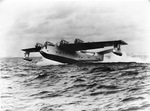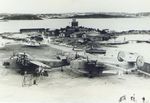PB2Y Coronado
| Country | United States |
| Manufacturer | Consolidated Aircraft |
| Primary Role | Seaplane |
| Maiden Flight | 17 December 1937 |
Contributor: C. Peter Chen
ww2dbasePB2Y Coronado flying boats were designed as the successor to the PBY Catalina flying boats. Orders for two prototype aircraft were placed in 1936, and the maiden flight took place in Dec 1937. After fixing stability issues with the prototype aircraft, the production design was designated PB2Y-2. PB2Y-3 variant design was completed shortly after the start of the Pacific War, which featured additional armor and self-sealing fuel tanks. In US Navy service, they saw both combat (bombing and anti-submarine warfare) and non-combat (transport and ambulance) roles, though the latter was much more commonplace. Ten PB2Y Coronado aircraft were also sent to the United Kingdom via the Lend Lease program; the British used them purely as transports, flying trans-Atlantic routes. Later in the war, despite engine upgrade and increased fuel capacity (PB2Y-5), the US Navy also relegated them to transport roles only. They were all scrapped shortly after WW2. During the design's production life, 217 examples were built.
ww2dbaseSource: Wikipedia
Last Major Revision: Jun 2011
PB2Y Coronado Timeline
| 17 Dec 1937 | PB2Y Coronado flying boat took its first flight. |
SPECIFICATIONS
PB2Y-5
| Machinery | Four Pratt & Whitney R-1830-92 radial engines rated at 1,200hp each |
| Armament | 3x2x12.7mm M2 Browning machine guns in 3 turrets (nose, dorsal, tail), 2x12.7mm M2 Browning machine guns in waist mounts, 2 Mark 13 torpedoes or up to 5,400kg of bombs |
| Crew | 10 |
| Span | 35.00 m |
| Length | 24.20 m |
| Height | 8.40 m |
| Wing Area | 165.00 m² |
| Weight, Empty | 18,530 kg |
| Weight, Maximum | 30,000 kg |
| Speed, Maximum | 310 km/h |
| Speed, Cruising | 272 km/h |
| Service Ceiling | 6,250 m |
| Range, Normal | 1,720 km |
Photographs
 |  |  |  |
Did you enjoy this article or find this article helpful? If so, please consider supporting us on Patreon. Even $1 per month will go a long way! Thank you. Share this article with your friends: Stay updated with WW2DB: |
Visitor Submitted Comments
29 Jul 2012 01:58:00 PM
I've seen some sources state that the early Coronados were powered by Wright R-2600 engines and the re-powered with P&W 1830s. If this is true, does anyone know why?
4 May 2013 03:07:07 PM
Experimented with Wright Cyclone R-2600 in place of Pratt-Witney R-1830. They wanted to see if the
addional 500HP would be better. Wright 1700HP--PW1200HP. Didn't work out. Less maintence problems with PW Engines.
All visitor submitted comments are opinions of those making the submissions and do not reflect views of WW2DB.
- » Wreck of USS Edsall Found (14 Nov 2024)
- » Autumn 2024 Fundraiser (7 Nov 2024)
- » Nobel Peace Prize for the Atomic Bomb Survivors Organization (11 Oct 2024)
- » Wreck of USS Stewart/DD-224 Found (2 Oct 2024)
- » See all news
- » 1,150 biographies
- » 337 events
- » 43,917 timeline entries
- » 1,241 ships
- » 350 aircraft models
- » 207 vehicle models
- » 375 weapon models
- » 123 historical documents
- » 260 facilities
- » 470 book reviews
- » 28,545 photos
- » 432 maps
Winston Churchill
Please consider supporting us on Patreon. Even $1 a month will go a long way. Thank you!
Or, please support us by purchasing some WW2DB merchandise at TeeSpring, Thank you!
19 Jun 2011 12:28:55 AM
The ten aircraft, designated PB2Y-3B. supplied to the RAF were based initially at Beaumaris, Anglesey, for service with Coastal Command. Their stay there was only brief, for they were transferred to No.231 Squadron of Transport Command and used from June 1944 to operate freight services.